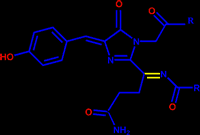Reference: NC Shaner, GH Patterson, MW Davidson: Advances in fluorescent protein technology. J Cell Sci 120 (2007) 4247-60.
NC Shaner, RE Campbell, PA Steinbach, BNG Giepmans, AE Palmer, RY Tsien: Improved monomeric red, orange and yellow fluorescent proteins derived from Discosoma sp red fluorescent protein. Nature Biotechnology 22 (2004) 1567-72. L Wang, WC Jackson, PA Steinbach, RY Tsien: Evolution of new nonantibody proteins via iterative somatic hypermutation. Proceedings…Read More
Reference: DM Chudakov, VV Belousov, AG Zaraisky, VV Novoselov, DB Staroverov, DB Zorov, S Lukyanov, KA Lukyanov: Kindling fluorescent proteins for precise in vivo photolabeling. Nature Biotechnology 21 (2003) 191-94.
References: RE Campbell, O Tour, AE Palmer, PA Steinbach, GS Baird, DA Zacharias, RY Tsien: A monomeric red fluorescent protein. Proceedings of the National Academy of Sciences of the United States of America 99 (2002) 7877-82. H Mizuno, TK Mal, KI Tong, R Ando, T Furuta, M Ikura, A Miyawakil:…Read More
Reference: LA Gross, GS Baird, RC Hoffman, KK Baldridge, RY Tsien: The structure of the chromophore within DsRed, a red fluorescent protein from coral. Proceedings of the National Academy of Sciences of the United States of America 97 (2000) 11990-95.
Reference: RE Campbell, O Tour, AE Palmer, PA Steinbach, GS Baird, DA Zacharias, RY Tsien: A monomeric red fluorescent protein. Proceedings of the National Academy of Sciences of the United States of America 99 (2002) 7877-82.
Reference: MV Matz, AF Fradkov, YA Labas, AP Savitisky, AG Zaraisky, ML Markelov, SA Lukyanov: Fluorescent proteins from nonbioluminescent Anthozoa species. Nature Biotech. 17 (1999) 969-73.
Reference: Miyawaki, A., Llopis, J., Heim, R. et al. Fluorescent indicators for Ca2+based on green fluorescent proteins and calmodulin. Nature 388, 882–887 (1997). https://doi.org/10.1038/42264
Resource: K Brejc, TK Sixma, PA Kitts, SR Kain, RY Tsien, M Ormo, SJ Remington: Structural basis for dual excitation and photoisomerization of the Aequorea victoria green fluorescent protein. Proceedings of the National Academy of Sciences of the United States of America 94 (1997) 2306-11.
References: A Miyawaki, J Llopis, R Heim, JM McCaffrey, JA Adams, M Ikura, RY Tsien: Fluorescent indicators for Ca2+ based on green fluorescent proteins and calmodulin. Nature 388 (1997) 882-87. A Miyawaki, O Griesbeck, R Heim, RY Tsien: Dynamic and quantitative Ca2+ measurements using improved cameleons. Proc. Nat. Acad. Science…Read More
